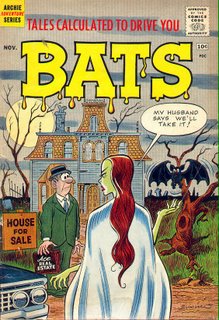Occasionally a curious person will ask me, "What's the oldest comic book you have in your collection?"
I think it's a fair question, but my answer is, "I don't know." I'm surrounded by books and comics. Half the time I can't remember what I have. However,
Uncle Scrooge #7, September-November, 1954, is the oldest comic book I still have that I personally bought off the comic book rack. That I remember.
My first experiences with comics were with two boxes of coverless and otherwise poor-condition books. The first box was in my neighbor Allen's basement. He led me down some wooden stairs.* I sat under a light set up by the furnace and looked at comics his older brothers and sisters had read to pieces. As I recall, they included one with a horror story about a flower turning into a gorilla — or was it the other way around? — and a coverless issue of
The Human Torch. I was mighty impressed by that flaming on stuff!
The other box of comics was one given to me by my cousin, Dickie. It included a lot of Dell Comics, like
Francis The Talking Mule, Bugs Bunny, Porky Pig, and many Walt Disney titles. That was in 1953. I was a first grader, six-years-old. I was bright enough, but up until that point a bad reader, because I didn't have anything interesting to read. Let's face it, the
Dick and Janereaders, as collectible as they are today, weren't The Human Torch or a flower turning into a gorilla. "Run, Spot, run!" Oh, yeah. That's just fascinating. Yawn. It took my interest in reading comics, brought on by those boxes of old comics, to put me in front of the first grade reading group.
I bugged Mom until she caved in and let me buy some of my own comic books. At that time there was a lot of publicity about horror and crime comics rotting kids' minds, so she was careful what she let me buy. Years later she said, "I worried you'd be scared by
Casper The Friendly Ghost."
In those days my favorite comics were the Disney's, and specifically
Uncle Scrooge. I wasn't alone. I believe at the time these comics sold in the millions.
Uncle Scrooge #7 was a special favorite and I have hung onto it for 52 years. As you can see from the scans the book is in real battered shape…the back cover even worse than the front. That was because I read it many, many times.
For anyone unfamiliar with the story, Scrooge looks for new ways to make money. He already owns everything in town. He finds Donald and his nephews collecting arrowheads to sell and he joins in. Through a series of comic events they find themselves in the Seven Cities of Cibola, where they find a Spanish treasure but also the terrible Beagle Boys, Scrooge's longtime nemeses. Anyone who read this comic and loved it as much as I did recognized the scene in
Raiders Of The Lost Ark where Indiana Jones removes an idol only to set off a booby trap and find himself outracing a large boulder.
The gag was set up in Uncle Scrooge #7. The
Raiders producer, George Lucas, had a partner, Gary Kurtz. Under the publishing imprint, Celestial Arts, Kurtz reprinted the story in 1982 as one in a deluxe edition of Uncle Scrooge stories,
Uncle Scrooge McDuck His Life And Times by Carl Barks.
Uncle Scrooge #7 is not the oldest comic book in my collection by a long shot. It's not the first comic book I bought. But it is the oldest comic book I bought that I still own. Because of its condition no one would ever want to own it but me, and maybe I'll have someone throw it in my casket when they lower me into the ground.
*Whenever I think about descending into that basement Danny Elfman's theme from
Tales From The Crypt goes through my head.






















































